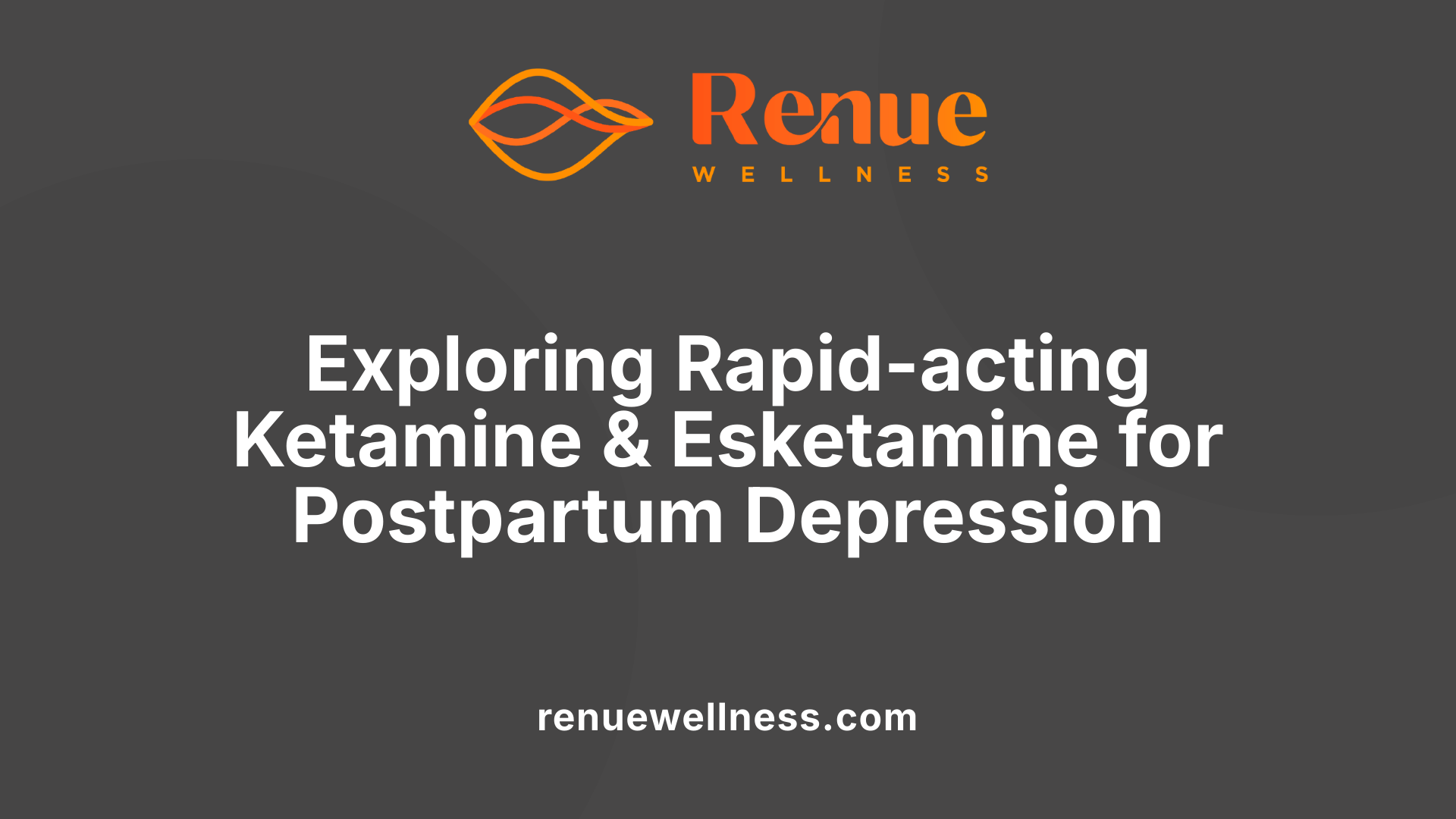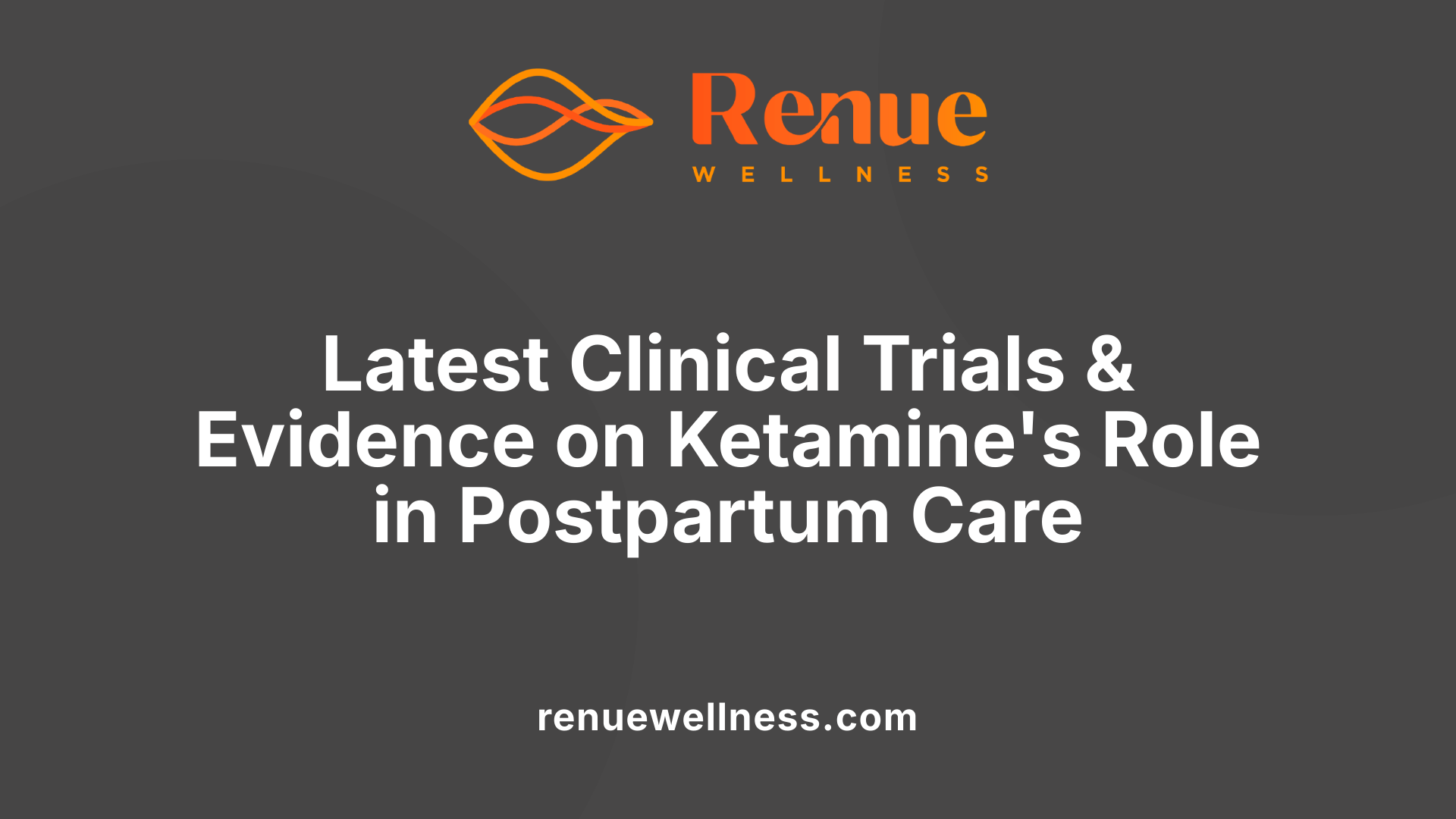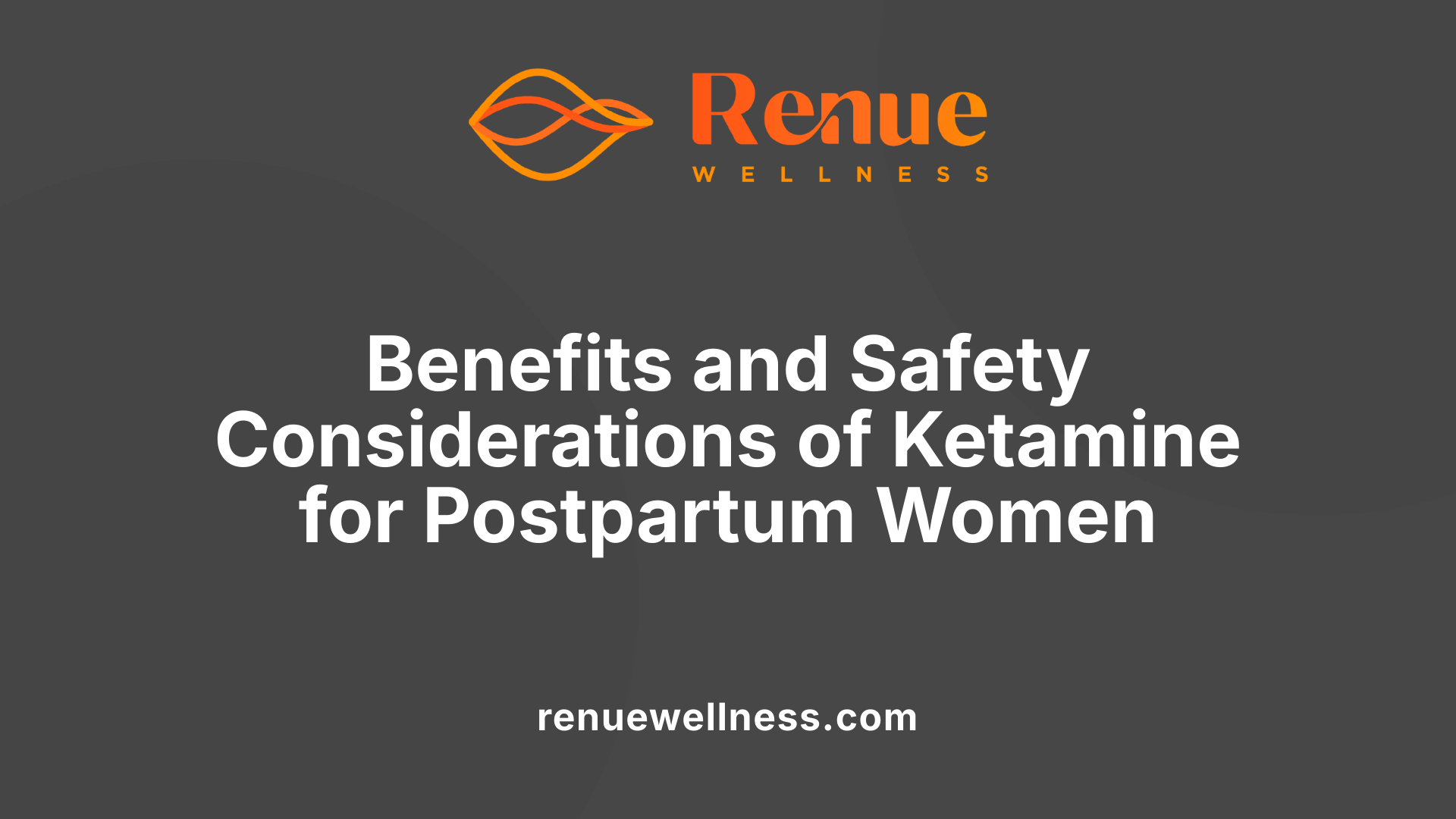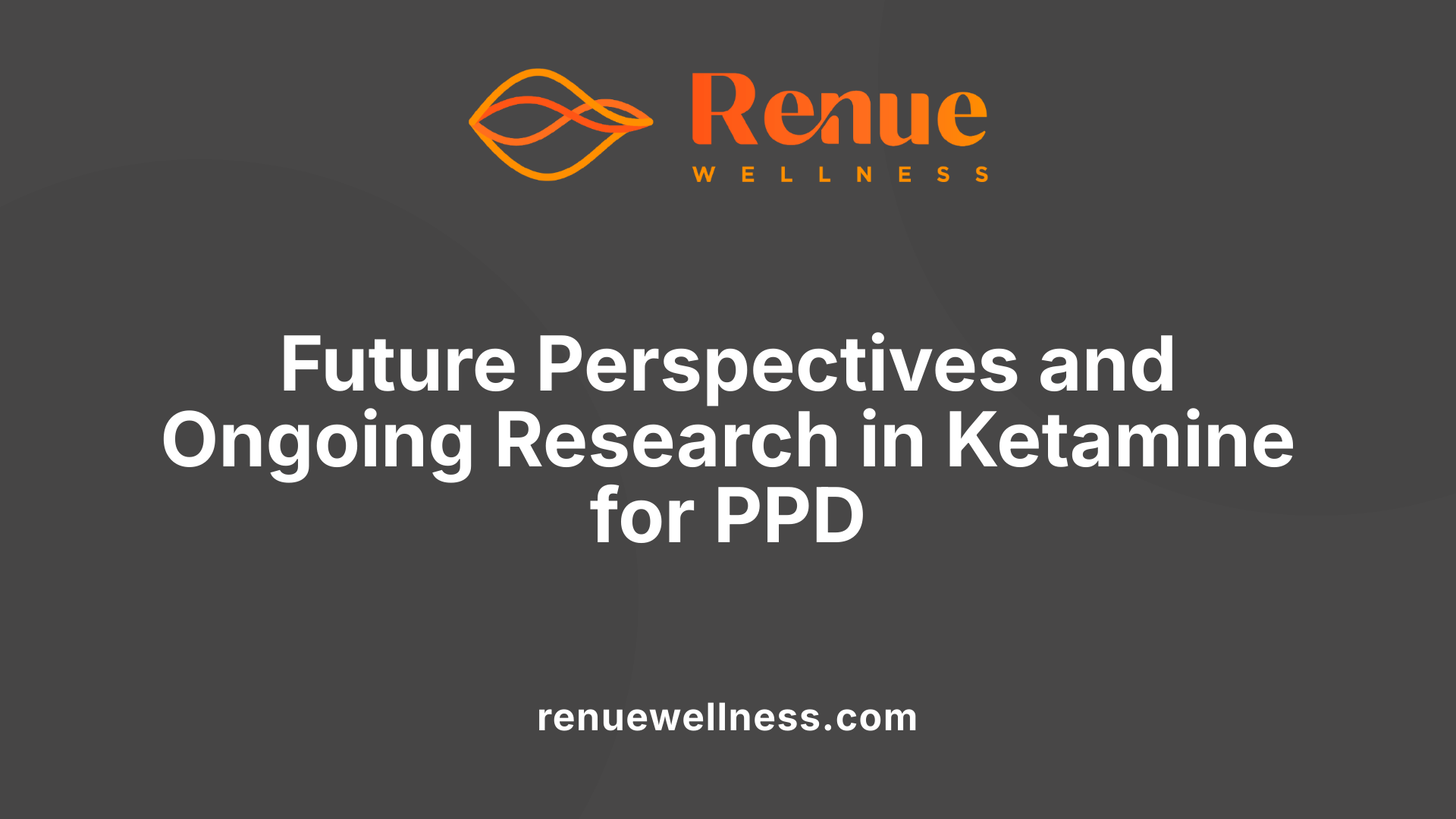Women’s Health Month: Ketamine for Postpartum and Depression


July 28, 2025
Women’s Health Month Spotlight: Exploring New Horizons in Postpartum Depression Treatment
As part of Women’s Health Month, it’s essential to highlight advances in mental health care for mothers. Postpartum depression (PPD) affects roughly one in seven mothers worldwide, impacting both maternal and infant well-being. Recent scientific interest has centered on the potential of ketamine and esketamine—known for their rapid antidepressant effects—to transform PPD management. This article explores current research, efficacy, safety, and future prospects of ketamine-based therapies in postpartum care.
Understanding Ketamine and Esketamine in Postpartum Treatment

What is the current scientific understanding of ketamine and esketamine as treatments for postpartum depression?
Recent research has opened new possibilities for treating postpartum depression (PPD) with ketamine and esketamine. These medications are recognized for their rapid antidepressant effects, which are particularly beneficial during the postpartum period when timely intervention is crucial.
Multiple high-quality studies, including randomized controlled trials and meta-analyses, demonstrate that both drugs can significantly lower depressive symptoms when administered shortly after childbirth. For instance, a recent large-scale study published in The BMJ showed that a single low dose of esketamine given immediately after childbirth reduced the incidence of PPD at 6 weeks postpartum from about 25% to less than 7%. Similarly, other trials involving women undergoing cesarean sections reported significant reductions in depression scores, with fewer cases of postpartum depression.
Most studies to date focus on women undergoing cesarean delivery, but preliminary evidence suggests benefits could extend to broader populations. The medications are thought to exert their effects by modulating neural pathways involved in mood regulation, acting quickly compared to traditional antidepressants.
Despite promising results, these treatments are still under investigation, and healthcare providers emphasize cautious use under medical supervision. Ongoing research aims to confirm their safety and effectiveness across diverse groups of postpartum women, ensuring that the benefits outweigh the risks.
In summary, ketamine and esketamine show significant potential as rapid-acting therapies for PPD. They could revolutionize postpartum mental health care, provided future studies continue to validate their safety and long-term benefits.
Current Clinical Evidence and Key Studies on Ketamine for Postpartum Depression

What does scientific research say about the efficacy and safety of ketamine-based therapies in postpartum women?
Recent studies, including multiple randomized controlled trials, indicate that ketamine and its derivative esketamine show promising results in managing postpartum depression (PPD). Evidence suggests that administering low doses of these drugs shortly after childbirth can significantly reduce the occurrence of postpartum depression. For example, a large study involving over 4,300 women found that a single low-dose esketamine injection reduced the risk of major depressive episodes at 42 days postpartum by approximately 75%. Similarly, other trials reported that intrapartum ketamine and esketamine decreased depression scores and lowered the incidence of PPD at 6 weeks.
In terms of safety, most transient side effects such as dizziness, sedation, hallucinations, and neuropsychiatric symptoms were observed but generally resolved quickly and did not require medical intervention. Blood pressure, heart rate, and oxygen saturation remained stable in these studies, suggesting safety for postpartum women under medical supervision.
While these findings are encouraging, current research emphasizes that the evidence base remains limited. Most studies highlight the need for further research to determine long-term safety, optimal dosing, and which women are most likely to benefit. Importantly, existing data do not definitively establish ketamine or esketamine as standard treatments for postpartum depression, but they offer potential alternatives, especially in cases where traditional therapies have failed or are contraindicated.
Dosing protocols and routes of administration
Research indicates that doses less than or equal to 0.5 mg/kg are effective in reducing postpartum depressive symptoms. Administration routes include intravenous infusion, particularly immediately after childbirth, and nasal spray (esketamine), approved by the FDA for treatment-resistant depression. For example, one study gave a 0.2 mg/kg dose of s-ketamine intravenously over 40 minutes postpartum, while others administered 0.25 mg/kg of esketamine during cesarean surgery.
The timing of administration varies, but most successful protocols have involved delivery immediately postpartum or during anesthesia induction. These approaches have demonstrated short-term benefits mainly within the first few weeks postpartum.
Comparison of ketamine and esketamine effects
Both ketamine and esketamine show similar efficacy in reducing postpartum depression symptoms, with some evidence suggesting esketamine may have added advantages due to its FDA approval and more favorable side effect profile.
Esketamine tends to produce more neuropsychiatric side effects such as dizziness or hallucinations, but these are generally transient. It also appears to be more effective in preventing long-term PPD compared to ketamine, as shown in recent trials where esketamine reduced the incidence of depression at 6 weeks postpartum significantly.
While ketamine's antidepressant effects are rapid and well-documented in other mood disorders, its safety and efficacy specifically in postpartum women continue to be explored. Both medications are administered under careful medical oversight to minimize risks.
| Aspect | Ketamine | Esketamine | Comments |
|---|---|---|---|
| Typical Dose | Less than 0.5 mg/kg | 0.25 mg/kg | Both effective at these doses |
| Administration Routes | IV, epidural | IV, nasal spray | Routes depend on clinical setting |
| Side Effects | Sedation, dizziness, hallucinations | Dizziness, dissociation | Usually transient |
| Efficacy | Reduces short-term PPD | Reduces short and long-term PPD | More evidence for esketamine |
| Approval Status | Off-label, experimental | FDA-approved for depression | Approved for treatment-resistant depression |
Overall, ketamine and esketamine represent promising options for postpartum depression, especially with rapid symptom relief, but they require more extensive research and careful clinical monitoring.
Benefits and Safety Profile of Ketamine in Postpartum Use

What are the potential benefits, risks, and considerations of using ketamine during the postpartum period?
Research indicates that ketamine and its derivative, esketamine, hold promise as rapid-acting treatments for postpartum depression (PPD). Clinical studies have shown that a single low dose of esketamine administered immediately after childbirth can significantly reduce the likelihood of major depressive episodes at 42 days postpartum, with reductions of up to 75%. For women undergoing cesarean sections, intraoperative esketamine infusion has been associated with lower depression scores at 6 weeks after delivery and a decreased incidence of PPD.
Beyond prevention, ketamine therapy has demonstrated effectiveness in reducing depressive symptoms shortly after delivery. This rapid action is particularly valuable because traditional antidepressants often take weeks to exhibit benefits. Both ketamine and esketamine have been linked to lower postpartum depression scores and smaller rates of depression onset, especially among women identified as high risk or resistant to conventional treatments.
However, use during the postpartum period is not without concerns. Temporary side effects such as sedation, dizziness, hallucinations, increased blood pressure, and dissociative sensations are common but usually resolve quickly without intervention. These neuropsychiatric effects tend to be transient, peaking during or shortly after infusion or injection. Blood pressure and vital signs generally remain stable, and no long-term adverse effects have been conclusively identified in humans.
Nonetheless, safety considerations extend beyond immediate reactions. Animal studies suggest possible neurodevelopmental impacts, especially with high doses of ketamine, although evidence remains inconclusive for standard therapeutic doses in humans. Limited data on breastfeeding indicates that ketamine's presence in breast milk is low, with a neonatal relative infant dose below 1%, suggesting minimal risk to infants. Still, monitoring for sedation and feeding difficulties is advised.
Given these findings, ketamine and esketamine can be viewed as promising options, particularly when traditional therapies fail or for prevention in high-risk groups. However, their use should be under strict medical supervision, considering the limited long-term safety data and potential side effects. Ongoing research is critical to clarifying appropriate dosing, safety parameters, and guidelines to optimize maternal and infant health outcomes.
More information search query:
benefits risks postpartum ketamine
Ketamine and Esketamine in Context of Broader Postpartum Mental Health Strategies
How does ketamine and esketamine therapy fit within the broader scope of postpartum mental health treatment options?
Ketamine and esketamine are gaining attention as promising options for managing postpartum depression (PPD), especially for women who do not respond well to traditional antidepressants. Unlike standard antidepressants, which often take weeks to show benefits, these drugs act rapidly, sometimes within hours or days. This quick response makes them especially valuable in postpartum scenarios, where early intervention can prevent long-term complications.
Recent clinical studies have demonstrated that both ketamine and esketamine significantly reduce depressive symptoms when administered shortly after childbirth. For instance, a single low dose of esketamine given post-delivery lowered the incidence of PPD by about 75% at 6 weeks postpartum. Similarly, ketamine used during cesarean anesthesia was associated with lower depression scores weeks after surgery.
These treatments can serve as adjuncts or alternatives to existing therapies, particularly in cases of severe or treatment-resistant postpartum depression. They may also be considered preventative, used shortly after childbirth to reduce the risk altogether. Side effects like dizziness, sedation, and hallucinations tend to be transient and well-managed under medical supervision.
While promising, ketamine and esketamine are not yet standard treatments for PPD. More research is needed to clarify optimal dosing, timing, and long-term safety. Nonetheless, their rapid action and potential preventive effects could complement current mental health care, expanding options for women during this vulnerable period.
Use of Ketamine During Pregnancy, Lactation, and in Perinatal Mental Health
What is known about the use of ketamine regarding pregnancy, lactation, and perinatal mental health?
Research on ketamine use during pregnancy is limited, and current evidence indicates potential risks for fetal development. Animal studies have shown concerning effects, especially at high doses, such as neurobehavioral issues, though data are inconsistent. Human data suggest that ketamine exposure during pregnancy does not appear to cause congenital defects, but some reports note developmental delays, with unclear effects related to first-trimester exposure.
In terms of neonatal outcomes, limited human studies have observed healthier early development, but there are reports of motor and language delays in the second year of life. The role of prenatal exposure, particularly in the first trimester, remains uncertain.
For breastfeeding, ketamine has a low relative infant dose (RID) of less than 1%, and breast milk levels tend to be minimal. Available data suggest that transfer into breast milk is low and unlikely to harm infants. Nonetheless, monitoring for sedation, poor feeding, or weight gain is recommended, and breastfeeding might be paused temporarily (6-12 hours) following administration to reduce potential risks.
During delivery, ketamine's influence on uterine tone and fetal vital signs warrants close monitoring. It may cause transient neuropsychiatric effects in mothers, such as dizziness or hallucinations, but these effects are usually short-lived.
Overall, current evidence indicates that ketamine's safety profile during pregnancy and lactation is not well-established and should be approached with caution. Health providers often recommend restricting its use during pregnancy unless other treatments have failed and the potential benefits outweigh the risks. More rigorous human studies are needed to better understand its long-term safety and efficacy in these settings.
In the context of perinatal mental health, research is ongoing into ketamine and esketamine as rapid-acting options for postpartum depression. Recent trials have demonstrated promising results, including significant reductions in postpartum depressive symptoms when administered after childbirth. However, their safety during pregnancy and breastfeeding remains insufficiently studied, emphasizing the importance of careful medical supervision and individualized risk assessment.
Scientific Evidence and Future Directions in Ketamine for Postpartum Depression

What is the scientific evidence supporting the use of ketamine for postpartum depression?
Recent research highlights promising results regarding ketamine and eketamine’s role in managing postpartum depression (PPD). Several studies demonstrate their potential benefits. For instance, a robust double-blind, randomized trial with 134 women undergoing cesarean deliveries found that a single dose of ketamine during anesthesia induction significantly lowered depression scores two and four weeks after birth. This suggests a preventive effect on postpartum depression.
Another notable study, published in The BMJ, involved 364 women with prenatal depression. It showed that a low dose of esketamine administered immediately after childbirth reduced the incidence of PPD at 6 weeks postpartum from 25.4% to just 6.7%. Blood pressure, heart rate, and oxygen levels remained stable, and side effects such as dizziness and sedation were transient.
Meta-analyses, including Wen et al. (2024) and Li et al. (2024), analyze data from multiple studies, confirming that esketamine notably lowers depression symptoms and reduces postpartum depression incidence within the first six weeks. The evidence points to its rapid action and promising prophylactic potential.
Despite these positive findings, the overall body of scientific evidence is still emerging. Most studies are limited in size, duration, or scope, and long-term safety data remain sparse. Many researchers emphasize the importance of further large-scale, controlled trials to thoroughly evaluate efficacy and safety, particularly concerning the effects on infants and mother-baby interactions. The current evidence supports ketamine as a potential, fast-acting option for postpartum depression, but broader clinical trials are necessary before it can be broadly recommended.
Summary and Conclusion: The Promise of Ketamine in Postpartum Mental Health
What is the scientific evidence supporting the use of ketamine for postpartum depression?
Recent research provides encouraging evidence for ketamine's potential in treating postpartum depression (PPD). A well-designed, double-blind, randomized trial involving 134 women undergoing cesarean surgery found that administering 0.5 mg/kg of ketamine during anesthesia induction led to significantly lower depression scores at two and four weeks after delivery. This suggests that ketamine may offer a preventive benefit against PPD.
In addition, a large BMJ study with 364 women demonstrated that a single dose of esketamine—derived from ketamine—administered immediately postpartum significantly reduced the incidence of major depressive episodes from 25.4% to just 6.7% at 42 days postpartum. The Edinburgh Postnatal Depression Scale (EPDS) scores also improved markedly in the esketamine group. Meta-analyses published in 2024 supported these findings, indicating that both ketamine and esketamine can lower the short-term risk of PPD and, in some cases, reduce long-term depression risk.
While these studies highlight ketamine's rapid antidepressant action and potential preventative role, they also underline the need for further research. Long-term safety data, optimal dosing strategies, and understanding which women are most likely to benefit remain areas for future exploration. Overall, current evidence suggests that ketamine holds promise as an innovative option for postpartum mental health management, but comprehensive clinical guidelines are yet to be established.
Emerging Perspectives and Continuing Research in Postpartum Mental Health
The growing body of evidence underscores the promising potential of ketamine and esketamine as rapid, effective treatments for postpartum depression. While preliminary studies and clinical trials demonstrate significant benefits in reducing depressive symptoms and incidence rates, especially in women undergoing cesarean sections or at high risk, comprehensive safety data and long-term outcomes remain limited. Women’s Health Month offers an important opportunity to spotlight these innovations and advocate for continued research. As our understanding deepens, ketamine-based therapies may become valuable tools in the postpartum mental health landscape—offering hope for faster recovery and better quality of life for mothers and their families.
References
- Is Ketamine or Esketamine an Option for the Treatment of ...
- The effect of ketamine on preventing postpartum depression - PMC
- Study Details | Low-dose S-Ketamine and Postpartum Depression in ...
- Intraoperative Esketamine and Postpartum Depression Among ...
- Efficacy of a single low dose of esketamine after childbirth ... - The BMJ
- Esketamine Found to Reduce Postpartum Depression
- Ketamine and Perinatal Mental Health: Problems and Potentials - PMC
- Efficacy and safety of ketamine and esketamine in reducing the ...
- Can Intravenous Ketamine Reduce Risk for Postpartum Depression?
Recent Posts
Conditions Treated
AnxietyDepressionOCDPTSDPostpartum DepressionPain ManagementSubstance AbuseSuicidal IdeationOur Location


